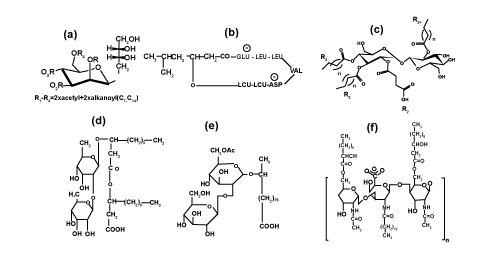Biosurfactant
Biosurfactants surfactants are molecules of microbial origin, which can be prepared on the basis of vegetable oil and sugar substrates. Just as surfactants non- microbial origin biosurfactants are amphiphilic, ie having both a hydrophobic and a hydrophilic part of the molecule. Thanks to this amphiphilic character, they are used to reduce surface tension or interfacial tension.
Biosurfactants are currently being produced and used, as they are not economically competitive compared to synthetic surfactants on the basis of oil in very small quantities. Critical micelle your (CMC ) is technically comparable to conventional nonionic surfactants.
Properties
Surface-active substances of microbial origin can be divided into different chemical groups. In this case, the glycolipids, lipopeptides and the lipoaminoacids, lipoproteins and lipopolysaccharides and phospholipids, mono-and diglycerides of fatty acids is of particular importance.
The glycolipids are the most widespread group of low molecular weight biosurfactants and can be divided into:
- Rhamnoselipide
- Sophoroselipids
- Trehalose and other mycolsäurehaltige glycolipids
- Cellobiose and mannosylerythritol lipids
The hydrophilic " head molecule " can be both non- ionic and ionic nature. This includes both mono-, di -and polysaccharides, as well as carboxylic acid, amino acid and peptide groups. The hydrophobic " tail molecule " normally consists of unsaturated, saturated or hydroxylated fatty acids.
Biotechnological production of biosurfactants
Biosurfactants, which are produced with the aid of bacteria or fungi, are of great interest for the Industrial Biotechnology. An advantage over the petrochemical production of surfactants is that biosurfactants (eg, vegetable oils, sugar in the form of syrup or molasses) can be produced from renewable resources. A surfactant- high efficiency and good biodegradability are more reasons to support the use of biosurfactants.
For some time the biotechnological production of biosurfactants has been established, but they have so far been used due to the high cost of production only in niche areas. Here are bsp. Rhamnose lipids ( rhamnolipid ), especially Pseudomonas aeruginosa, surfactin from Bacillus subtilis, emulsan of Acinetobacter calcoaceticus and Candida lipolytica and Liposan of sophorose lipid ( sophorolipid ) from Torulopsis bombicola produced. Cellobiose lipids can be formed during Corynomycolate and trehalose lipids by bacteria of the genera Corynebacterium and Arthrobacter are produced in the presence of alkanes or triglycerides of corn smut ( Ustilago maydis ). Particularly high yields in the production of sophorolipids with more than 400 g / l of suspension obtained during up to 110 mg / l of suspension may be achieved in most of the other biosurfactants.
Process optimization is a focus of current biotechnological research on biosurfactants. Due to the very good surfactant properties arises mainly the problem of foaming. Although there are good chemical anti-foaming agent (especially silicone oils), however, these may influence the product quality. In the current research, therefore, are alternatives in the test, such as the mechanical foam destruction.
Some biosurfactant - producing organisms such as Pseudomonas aeruginosa, the only significant producer Rhamnolipidmengen, are opportunistic pathogens and are therefore classified as potentially dangerous microorganisms. Dealing with them is coupled to appropriate technical measures and very expensive, alternative producers are currently in research. The surfactin of Bacillus subtilis has a very good surfactant, due to its haemolytic effect is not applied.
Application potential of biosurfactants
The use of biosurfactants spans in the Fundamental applications of chemically synthesized surfactants. Due to the potentially better biodegradability of biosurfactants special, environmentally relevant areas of application can be developed in addition, which are possible to chemically synthesized surfactants. Appropriate applications for biosurfactants are bsp. Uses in the field of bioremediation and environmental restoration ( eg after major oil spills treatment with trehalose dicorynomycolate ) and the tertiary oil recovery ( "Enhanced Oil Recovery "). However, the main applications are similar to those of synthetic surfactants in household and cleaning products, cosmetics, medicine, food process engineering and agriculture and plant protection, which also surfactants from oleochemical production (direct chemical reaction of vegetable oils ) are used.
Especially rhamnolipids find applications in household cleaners (Henkel, Ecover ), sophorolipids are mainly used in Japan in skin creams.










